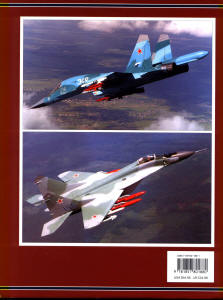|
Specialty Press |
|
Soviet/Russian Aircraft Weapons Since World War II |
|
by Yefim Gordon |
|
Reviewed By Mike Howard, #30741 |
|
|
|
ISBN : 1-85780-188-1 MSRP $44.95 For many years the veil of secrecy that shrouded the former U.S.S.R. made it difficult for modelers to obtain good information on the vast array of weapons that were carried on the various Russian military aircraft. Since the opening of the country in the late 80’s, there has been an increasing amount of information finding its way into specialty books and aircraft publications. This volume is a fine example of what’s now available to modelers and aviation enthusiasts in general. This hardback book is comprised of 208 pages, 260 color and B&W photos, and 16 pages of scale drawings. It’s broken down into 4 chapters and a color photo section at the back of the book. The 4 chapters are as follows: 1) “Shoot’em Down : The air-to-air missiles” - A very thorough description of the various stages of AAM development is covered from the late days of WWII through to the latest dog fighting missiles. Did you know that the Archer has 4 individual pitch and yaw vanes on the nose? 2) “Guided death from the skies” - Covered are the guided missiles used by the Soviets. Some of these look more like small aircraft with the cockpits removed! Air-to-ground, anti-ship, anti-radiation and cruise missiles are explained in depth. 3) “Moving Mud : The unguided rockets” - So often seen on Russian aircraft are the huge unguided rockets (up to 240 mm!) or mass of multiple shot rocket pods. These are well covered with drawings, text and pictures. 4) “Bombs Away” – The title of this chapter is self-explanatory. Anything from small practice bombs to laser guided munitions fill this section. Again a good selection of illustrations and text is included. The publisher’s information sheet indicates that there should also be coverage of gun pods, sub-munitions dispensers and podded target designators in this volume, but these items were not included in the sample copy that I received. The text is written from a Russian perspective so not all weapons descriptions include the NATO reporting name/designation. At times some additional research may be required for those accustomed to seeing only the Western titles for the various weapons. A lot of developmental history, technical descriptions and dimensional specifications are included for most of the items as well as a brief history on the Soviet weapons development system overall. Drawings and pictures of the weapons both on and off of the aircraft will be of great help to modelers wishing to add detail to the weapons, weapons pylons and, in some cases various parts of the aircraft. I found the last section especially interesting and helpful as it contains 31 pages of color photos with both old and new aircraft and their associated weapons. The shots span from the usual airshow “plane & weapons” displays to inflight weapons release pictures. Also noteworthy are some of the camouflage schemes shown in color. |
| Having recently completed a 1/72 Su-34 with five different weapons types loaded on it, I could definitely have used this book prior to completion to help understand what all of the items were that are now dangling from the pylons. It will definitely be used on the many future Russian aircraft kits that are in my inventory. I would highly recommend this book to anyone with an interest in the armaments of Russian jet aircraft from early times up until present. Thanks very much to Specialty Press for the review sample. |
|
|
|
Information, images, and all
other items placed electronically on this site |


